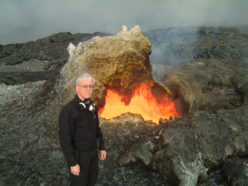Q: Hi!
Oxygen in our atmosphere was created by small creatures who had just invented a new process: photosynthesis.
The waste product of photosynthesis is oxygen.
After an unfathomable number of years, too much O2 built up in the atmosphere, changing the greenhouse gas, methane, into carbon dioxide, which isn’t such a strong greenhouse gas. This caused the earth to cool off to the point where the first known ice age began, the huronic, I think. It lasted for millions of years and enveloped the entire earth with ice.
Question 1: how did these photosynthetic creatures survive in an iced-over earth?
Question 2: what caused the end of this very long ice age?
Just curious – Thank you!
– Susan K
A: Your question suggests you are well along in studying this topic. I’ve stored a number of closely related questions and answers on this blog, and by way of a long answer, some of these may help:
http://askageologist.blogspot.com/2013/07/climate-change-is-it-real.html
http://askageologist.blogspot.com/2013/04/castastrophes-and-mass-extinctions.html
http://askageologist.blogspot.com/2012/06/snowball-earth-faint-young-sun-paradox.html
The medium-length answer: Our atmosphere passed through the oxygenation transition around 2.5 billion years ago, and it certainly involved photosynthesis – stromatolites (fossil algal clumps) have been found dating as far back as 3.3 billion years. However, there are also suggestions that mantle out-gassing, tectonics, and oceanic current-shifts may have contributed. There really was a Snowball Earth episode, and there have been a series of cold-warm cycles since then. Scientists have been exploring – with limited data considering how long ago it was and what little evidence remains – what could have caused these events. Suggestions range from the fairly mundane to the exotic: asteroid impact, tectonic change that interrupted oceanic current flows, etc. The Chicxulub asteroid event 65 million years ago certainly knocked the oxygen levels in the atmosphere down dramatically, requiring millions of years to recover. This is almost certainly why bar-headed geese can easily fly over Mount Everest: birds have evolved a truly advanced respiratory system (including hollow bones) since that event. Evolution is well-documented to speed up under environmental stress.
Some short answers:
- If there is one thing certain about microbial life, it is that it can survive almost anything. Microbes have been found many kilometers deep in the Earth, despite the fact that temperatures steadily increase with depth due to radio-isotope decay in the Mantle and Core of the Earth (the temperature rises to typically 60 C at 4,000 meters depth).
- There are a lot of variables that may have been involved in the recurring cool-warming cycles, including the fact that the Sun has steadily grown in luminosity during its 5-billion-year lifetime, as well as tectonics, and methane-emitting life forms. Likely a combination of these – and probably additional factors – led to out-of-control feedback loops that dead-ended in climate extremes before the atmosphere eventually recovered.
